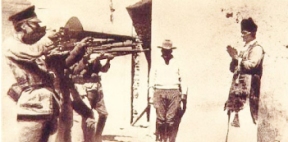
by Daniel Nardini
One of the biggest conflicts in Mexico’s history had been with that between the state and the Roman Catholic Church. Even though the Mexican independence movement was started and led by two priests (Miguel Hidalgo y Costilla and Jose Maria Morelos y Pavon), the Church by and large remained loyal to the Spanish Crown. The man who succeeded in gaining Mexico’s independence from Spain, Agustin de Iturbide, was able to win support from the Catholic Church to help secure the nation’s independence. But when Iturbide was ousted, the status of the Church became insecure. Worse, the Church and its clergy were treated brutally by Mexican government forces during the War of the Reform (1857-1861). During this period, the Church faced massive persecution, and this is why many in the Church threw their support behind the French invasion of Mexico (1862-1867). The French and their Mexican supporters lost, and this led to more persecution of the Church.
This persecution ceased when Porfirio Diaz seized power in 1876. He made peace with the Church, and that is how it remained until 1910. The Mexican Revolution brought back a great deal of the conflict between Church and state. The Mexican Constitution of 1917 stripped the Church of its properties, and prohibited religious education in the schools. Mexico’s President Alvaro Obregon further extended the persecutions against Catholics during his reign. Obregon’s successor, Plucarco Elias Calles, was no better in his treatment of the Church. For the most part, followers of the Church and its clergy tried passive resistance to the brutality of the state. But this persecution drove many to the breaking point. The breaking point came in 1926 when 400 Catholic followers armed themselves and took over a church in Guadalajara, Soon, the whole revolt spread throughout northern Jalisco state and into Durango where ranchers joined in an open rebellion.
The government’s move was swift and brutal. Thousands of Catholic rebels were massacred—many were hanged under trees and by lamp posts where their bodies were left to rot. Churches were burnt down and priests were slaughtered. The rebellion, called the Cristero War (after the words “Cristo del Rey” or Jesus the King uttered by Catholic followers before battle), tore Mexico apart and many feared the revolution would start over again. Despite what it felt towards the Mexican government, the Vatican tried to negotiate a peace between the Mexican government and the Mexican Catholic Church. The U.S. government, through its ambassador to Mexico, Dwight Whitney Morrow, also tried to convince Mexican President Calles of the necessity of making peace with the Catholic rebels. The peace process went back and forth, and was almost completely derailed when former Mexican President, and a good friend of Calles, Alvaro Obregon, was assassinated by a Catholic fanatic named Jose de Leon Toral.
Finally, in 1929, newly appointed and then elected Mexican President Emilio Portes Gil realized that something had to be done to end the rebellion. President Portes allowed the Church to keep some of their lands, reopen the churches for church services, allow some religious education, and end government persecution of the Catholics. While some anti-religious laws remained in the legal books in Mexico for decades after this, the Catholic Church was allowed gradually to be able to have complete freedom of practice and to co-exist with the state. Today, there is no issue of freedom of religion—the Mexican government in 1992 finally changed that part of the Constitution so now there is complete freedom of religion and the Catholic Church is free to practice and exist. In a world where religious persecution and wars still very much take place, Mexico has become one of those countries where freedom of religion and tolerance of all religions is a constitutional guarantee.











